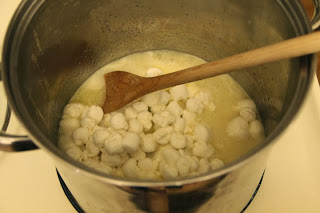They say that when life gives you lemons, you should make lemonade. But what about when life (in the form of your parents) give you a bag full of delicious homegrown onions and multi-color potatoes? Katie says you should make venison stew in bread bowls! And she is correct.
 |
| She started with four small venison chops, chopped. Or cut into dice-sized cubes. Proper chefs probably have different definitions for each of those sizes. Katie picked her favorite size, and seared them up in a frying pan. |
 |
| Then she found some top-notch veggies. (Thanks, Mom and Dad!) |
 |
| She chopped those up, too, and then found a couple carrots and celery stalks, which received similar treatment. She added everything to a big ol' crock pot with a pint of chicken stock and added water to cover the rest. She also seasoned the whole deal with salt, pepper, brown sugar, garlic powder, "a few shakes of hot sauce," and thyme so the house would smell awesome all day. |
 |
| Then she set about making bread bowls. The recipe for the dough is below. One regular loaf makes four good-sized bread bowls. |
 |
| When they're done cooking, they have a similar color to a seasoned stoneware cookie sheet, but taste a lot better. |
 |
| Then Katie cut out a plug of bread from the top and scooped out most of the inside with a spoon, so it looks like the top of a dormant volcano. |
 |
| But it's not dormant! It's about to explode with venison stew and cheese! Look out, Pompeii! Ahhhhhh! |
The Recipe:
0.5-1 lb package of venison chops, cubed (or diced, or whatever)
5 medium sized potatoes, cut like the venison
1 large onion, cut the same
2 carrots, cut...you get the idea
2 stalks celery, whole! (just checking to see if you were paying attention. Chop the celery like everything else)
1 pint chicken stock
Water to cover
Seasonings to taste: salt, pepper, brown sugar, garlic powder, hot sauce, and thyme
Flour to thicken
Sear the meat in a frying pan. While it's cooking, chop vegetables and add to crock pot, along with chicken stock. Set crock pot to 'high,' and add seared meat when it's done, along with water to cover and seasonings. Cook 5-6 hours on 'high' setting, or until vegetables are tender. Adjust seasonings and add four to thicken. We ended up using about a tablespoon each of salt, pepper, and brown sugar, and two tablespoons each of garlic powder and thyme, and about three squirts of hot sauce. About a quarter-cup of flour was enough to thicken it to our preference. Scoop out bread bowls, fill with stew, and top with shredded cheese. Eat delicious volcano.
Bread bowls:
2 cups warm water (~105 °F)
0.25 cup sugar
1 t salt
4 tablespoons oil or butter
4 teaspoons active dry yeast
2 cups bread flour
3.5-4 cups whole wheat flour
Add yeast and sugar to water, allow to proof for five minutes or so. Add oil, flour, and salt (salt last). Mix well and knead for 10-15 minutes. Allow to rise in warm place for 45 minutes, then punch down, form into eight bread bowls, and set on greased cookie sheet. Cover with a towel and let rise for another 45 minutes. Bake at 350 °F for 18-20 minutes, or until a hard crust has formed.
What do you do when life gives you potatoes and onions? Do you have a favorite venison stew recipe? Which of your suppers do you pretend are actually volcanoes? Let us know in the comments section below!






















































